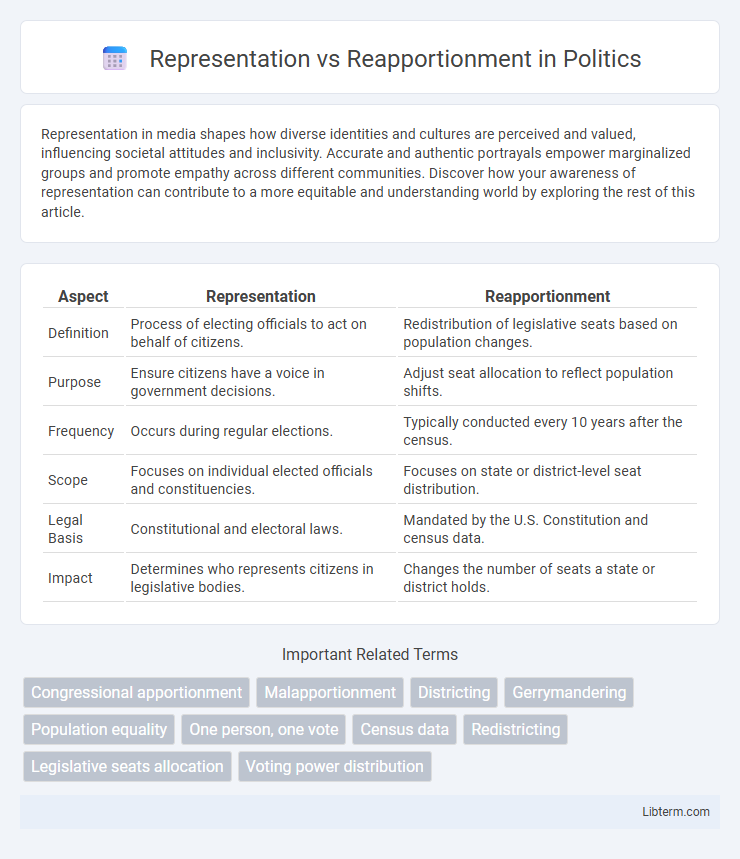Representation in media shapes how diverse identities and cultures are perceived and valued, influencing societal attitudes and inclusivity. Accurate and authentic portrayals empower marginalized groups and promote empathy across different communities. Discover how your awareness of representation can contribute to a more equitable and understanding world by exploring the rest of this article.
Table of Comparison
| Aspect | Representation | Reapportionment |
|---|---|---|
| Definition | Process of electing officials to act on behalf of citizens. | Redistribution of legislative seats based on population changes. |
| Purpose | Ensure citizens have a voice in government decisions. | Adjust seat allocation to reflect population shifts. |
| Frequency | Occurs during regular elections. | Typically conducted every 10 years after the census. |
| Scope | Focuses on individual elected officials and constituencies. | Focuses on state or district-level seat distribution. |
| Legal Basis | Constitutional and electoral laws. | Mandated by the U.S. Constitution and census data. |
| Impact | Determines who represents citizens in legislative bodies. | Changes the number of seats a state or district holds. |
Understanding Representation in Governance
Representation in governance ensures that constituents' interests are voiced through elected officials, reflecting the population's diversity within legislative bodies. It involves allocating seats based on population to maintain political equity, ensuring smaller and larger regions have fair influence. Effective representation requires responsive officials who advocate for community needs while maintaining accountability in democratic processes.
Defining Reapportionment: Core Concepts
Reapportionment is the process of redistributing the number of seats in the House of Representatives among states based on population changes recorded in the decennial U.S. Census. This adjustment ensures each state's congressional representation reflects shifts in population, maintaining equal representation across the country. The core concept revolves around proportionally allocating 435 seats according to the latest demographic data, influencing political power and federal resource distribution.
Historical Evolution of Representation
The historical evolution of representation in the United States began with the Articles of Confederation, which established a unicameral legislature with equal representation for each state, regardless of population. The Constitution replaced this with a bicameral Congress, featuring the House of Representatives based on population and the Senate with equal representation, balancing the interests of large and small states. Over time, reapportionment has adjusted House seats according to census data, reflecting population shifts and demographic changes across states.
The Legal Framework Behind Reapportionment
Reapportionment is governed by the constitutional requirement to ensure equal representation based on population changes identified in the decennial census, adhering to the principle of "one person, one vote" established by landmark Supreme Court cases such as Baker v. Carr and Reynolds v. Sims. The legal framework mandates that legislative districts within states be redrawn to reflect population shifts, preventing disproportionate influence by any group and maintaining equitable political representation. Federal laws, including the Voting Rights Act of 1965, further oversee reapportionment to prohibit racial gerrymandering and protect minority voting rights.
Representation vs Reapportionment: Key Differences
Representation refers to the allocation of political power or legislative seats to individuals or groups based on population or other criteria, ensuring constituents have elected officials advocating for their interests. Reapportionment is the process of redistributing legislative seats among different districts or states, typically following a census, to reflect population changes and maintain equal representation. The key difference lies in representation as the concept of having elected officials per population, while reapportionment is the procedural adjustment of seat distribution to uphold fair representation.
Impact on Electoral Systems
Representation determines how citizens' interests are reflected through elected officials, shaping the structure of legislative bodies, while reapportionment adjusts the allocation of legislative seats based on population changes to ensure equal representation. Accurate reapportionment prevents disparities in voter influence by realigning districts to demographic shifts, maintaining the principle of "one person, one vote." This process directly impacts electoral systems by influencing electoral competitiveness, party dominance, and the balance of power within legislatures.
Demographic Changes and Reapportionment
Demographic changes directly impact reapportionment by redistributing congressional seats based on population shifts identified in the decennial census. States experiencing population growth gain additional representation in the House of Representatives, while those with declining populations may lose seats. This process ensures that political representation aligns with current population data, maintaining equitable voter influence across states.
Common Challenges in Representation and Reapportionment
Common challenges in representation and reapportionment include ensuring equitable population distribution among districts, addressing gerrymandering, and maintaining fair political representation for minority groups. The accuracy of census data greatly impacts reapportionment, resulting in potential under- or over-representation if populations are miscounted. Balancing legal requirements, demographic shifts, and political interests often complicates the redistricting process, leading to disputes and legal challenges.
Case Studies: Global Approaches to Apportionment
Representation varies globally, with countries adopting different apportionment strategies to balance population and political influence; for instance, the United States uses reapportionment every ten years based on the decennial census, while India employs a frozen apportionment system since 1976 to maintain regional equity despite population shifts. In contrast, Germany allocates Bundestag seats through a mixed-member proportional representation system, combining direct and party-list seats to ensure proportionality and regional representation. These case studies highlight diverse global approaches that address demographic changes, political stability, and equitable representation challenges in legislative bodies.
Ensuring Fairness in Representation and Reapportionment
Ensuring fairness in representation and reapportionment involves adjusting legislative districts to reflect population changes accurately, guaranteeing equal voter influence. The principle of "one person, one vote" mandates that districts contain roughly equal populations to uphold equitable representation in legislative bodies. Regular reapportionment based on census data prevents malapportionment and protects minority voting strength, fostering a democratic system that fairly represents diverse populations.
Representation Infographic

 libterm.com
libterm.com